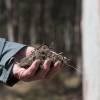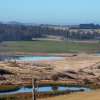
Newly developed protocol a vital tool for safeguarding forestry industry
Posted 08 August 2024
Pine Wood Nematode is a biosecurity pest of pine trees that is very difficult to tell apart from other, harmless teeny tiny nematodes.
The Pine Wood Nematode (PWN) poses a severe threat to pine forests globally, with significant impacts in countries where it has been introduced, such as Japan, China, and Portugal. The nematode disrupts the tree's water transport system, leading to rapid wilting and death.
Australia is taking proactive measures to prevent the incursion of PWN. The new National Diagnostic Protocol, developed by experts at CSIRO, focuses on accurate and timely identification, which is crucial for early intervention and management.
Maintaining Australia's biosecurity requires vigilance and preparedness. The protocol integrates advanced molecular techniques to distinguish PWN from other nematodes, ensuring precise diagnosis. This initiative reflects a broader effort to safeguard the forestry industry and natural ecosystems from invasive pests and diseases.
For further details, you can read the full article here.
Share this Article
Latest Articles
-

20 October 2025
Tasmanian High Soil Carbon Landscapes project
-

17 September 2025
Celebrating excellence at the Tasmanian Timber Awards
-

17 September 2025
Forest Practices Authority Research Update Day
Archives
- ActivAcre hits milestone, calls for more farmers to get on board
- Napier's leading the way in sustainable forestry and carbon-neutral farming
- Sound science needed to assess carbon impacts of timber harvesting
- Newly appointed TFFPN Board of Directors
- Graduate Certificate of Forestry Scholarship
- Forestry Australia Mentoring Program 2025
- Forest Industry Roundtable planning for the long term
- Eagle Management Constraint Period extended
- Successful private native forest management celebrated
- $15 million investment in new ship loader to boost Bell Bay's forestry exports
- Standing with Tasmania's forestry industry: buy local
- TFPA: Tasmanian Freight Equalisation Scheme needs a ground-up review
- AFCA Gala Dinner celebrates industry excellence
- Fire permits now required Statewide
- Forest leaders hone skills in sustainable native regrowth management
- Tasmanian forests and the carbon market: Barriers and opportunities
- What the 2024-25 Tasmanian Budget means for forestry
- Spring is the time for fuel reduction burning
- Primed for Growth: A situation analysis of the Tasmanian Forest and Wood Products Sector
- Audit requirements cut for low-risk plantation projects
- Guidance and support for landowners after damaging winds
- Forestry Australia welcomes further definition of active forest management
- Farm & Forest Mapper Tool highlighted at Rural Youth Tasmania's Young Farmer of the Year competition
- Senate Select Committee inquiry into the Tasmanian Freight Equalisation Scheme
- Timberlink announces new wood composite products brand
- Newly developed protocol a vital tool for safeguarding forestry industry
- Red Hot Tips: Fire management for Tassie farmers
- Bioenergy: Fuelling industries with trees
- Harvesting trees: What you need to know
- Shelterbelts: How are they contributing to farm systems?
- Infill plantings and remnant vegetation: Why biodiversity depends on a thriving understory
- Plantation planning: The key to a successful plantation
- Exciting interactive forestry knowledge hub launched
- $450,000 farm forestry grant recipients revealed


